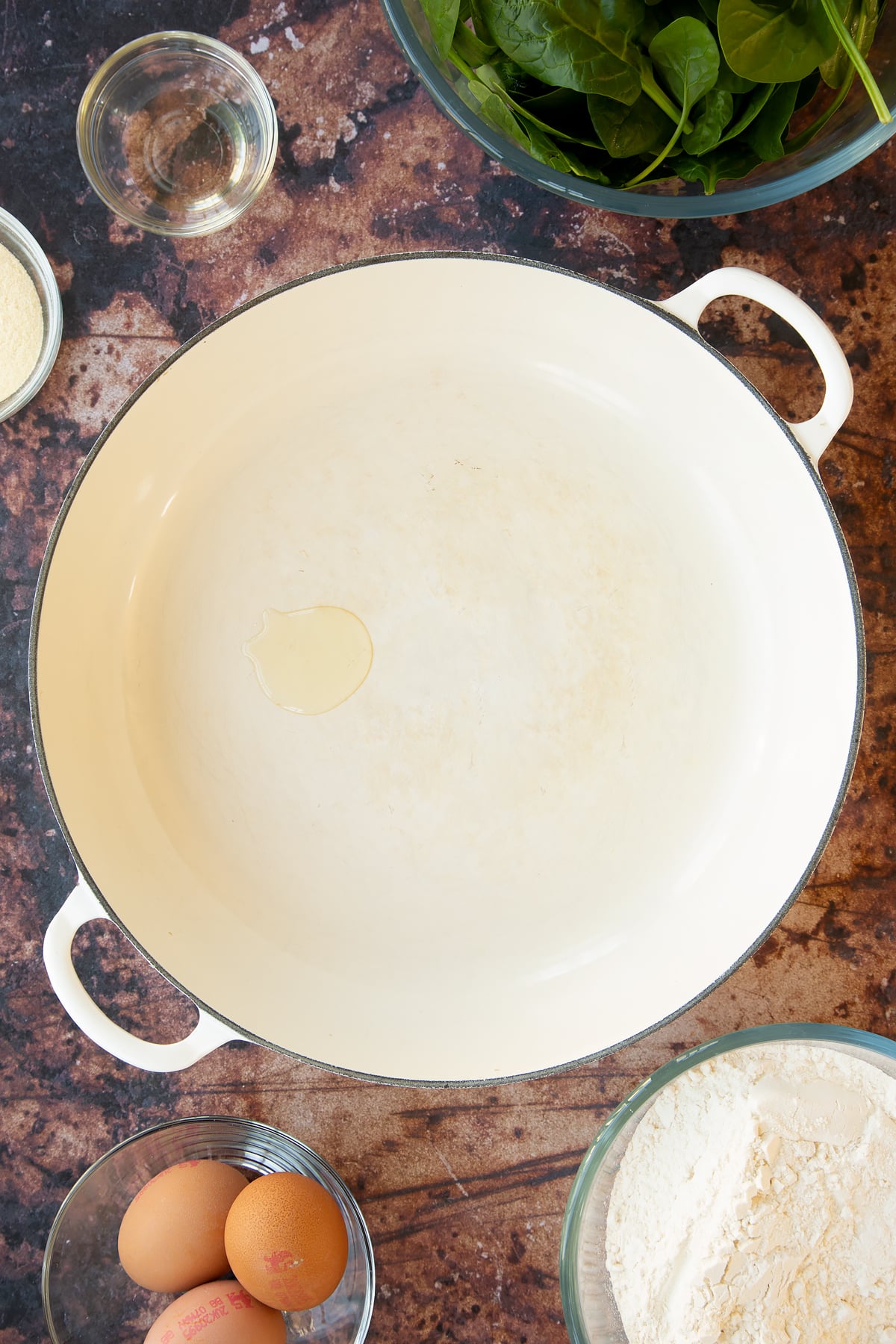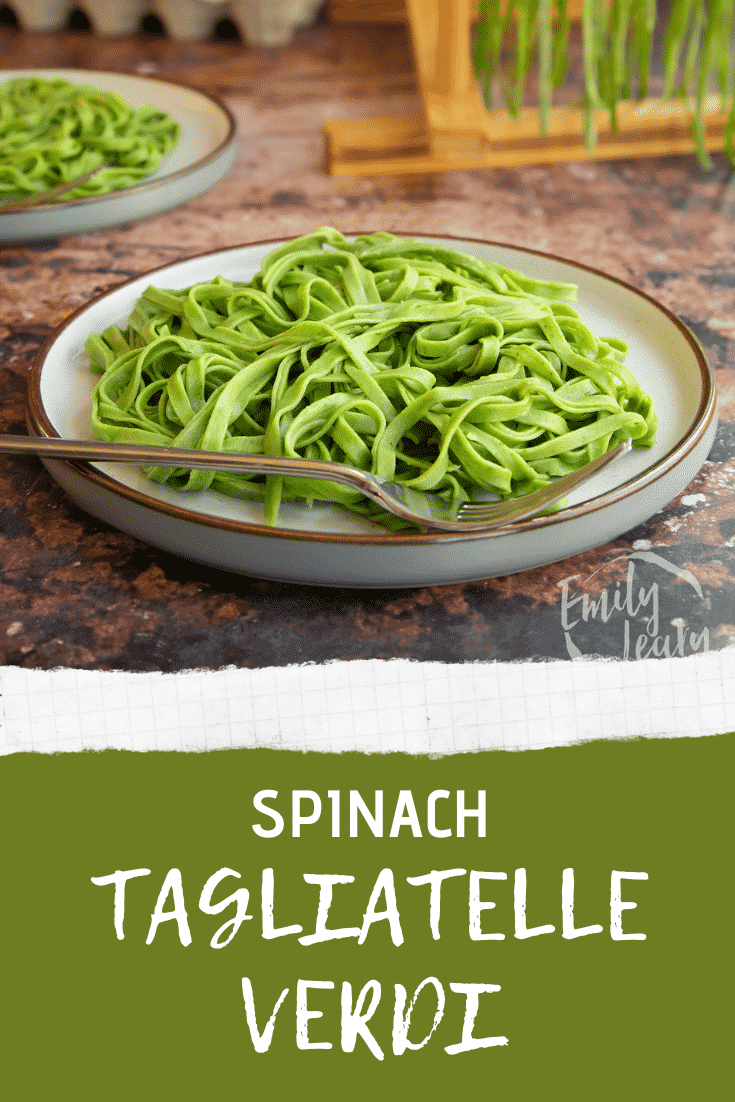Tagliatelle verdi is a from-scratch fresh pasta recipe made with spinach to give a naturally vibrant, verdant bright green hue.

And on top of the beautifully appetising colour, there's lots more to love about tagliatelle verdi too: the deliciously subtle flavour, the perfectly al dente texture and the fact that's it very, very easy to make!
To make tagliatelle verdi, you'll start by wilting fresh, tender spinach in just a touch of olive oil and then squeezing out the excess moisture.

After that, you'll transfer your spinach to a blender bowl and blitz with eggs to give a rich, bright green liquid base. All that's left to do is add flour and whizz again and your dough is made.
Kneading pasta dough isn't as time consuming as kneading bread dough. Instead, you'll turn the sticky green dough over on your counter just enough to achieve a lovely smooth consistency, then rest to let the gluten relax.

Once your dough is resting, you'll be ready to have fun running it through the pasta maker, first making sheets and then cutting into those distinctive tagliatelle ribbons, ready to boil, serve and enjoy!
Don't worry if you've never used a pasta machine before! I've included lots of detailed instructions and step-by-step photos below so that you can be confident at every stage.
Here's the full recipe for my tagliatelle verdi.
Ingredients
- 1 tsp olive oil
- 100 g (3.5 oz) fresh spinach
- 250 g (1¾ cups) "00" pasta flour plus some to dust
- 2 medium eggs
- 1 medium egg yolk
- 2 tbsp semolina to dust the tray
Instructions
Make the tagliatelle verdi dough
Warm the oil in a pan.

Add the spinach.

Wilting for just 1-2 minutes.

Tip the spinach into a sieve and press out the excess water, then add to the bowl of your food processor along with the eggs and egg yolk.

Blitz until you have a smooth green liquid.

Add the flour to the food processor.

Start pulsing the motor. You'll need to scrape down the sides and bottom of the blender bowl a few times to ensure everything is combined into a clumpy, vibrant green dough. Gather the dough and transfer to a clean surface.

Knead until you have a smooth, even dough.

Cover with cling film and leave to rest for 20-30 minutes to make it easier to work with.
Roll and cut the tagliatelle verdi
Divide the pasta dough in half, working one piece at a time whilst keeping the other wrapped to prevent it from drying out.

Shape the piece into a rectangle and set the pasta machine to its widest setting. Pass the pasta through the machine, then fold up and pass through again at 90 degrees from the folds. Repeat until you have a smooth sheet without tears, splits or dry patches.

You can now reduce the number on your machine by one and pass the pasta through again twice. Keep working down the numbers, passing the pasta through twice each time and dusting with a tiny bit of flavour if it sticks until you are down to the penultimate setting (e.g. if your machine runs from 7 down to 1, stop at setting 2).
Dust the underside of the strip very lightly with flour so that it doesn't stick and lay it out flat. Cut it in half so that you have two shorter strips, side by side.

Repeat with the other piece of dough.

Give all the sheets 5-10 minutes to dry out a bit - turning halfway to allow them to dry on both sides. Your pasta sheets should lose their stickiness but should not be left so long as to go stiff or brittle.
Starting with the first ones you made, start running your sheets through the pasta machine’s tagliatelle setting one by one.

As you roll your tagliatelle, there is a danger of it clumping together if left to sit. To avoid this, you have two options...

You can dust your tagliatelle lightly with semolina and form into little nests on a tray.
Alternatively, you can hang your tagliatelle verdi on a pasta drying rack or improvise something similar. When my kids were babies, I'd tie baker's twine between two kitchen cabinet handles and hang the pasta that way!

Cook the tagliatelle verdi
Fill a large pot with boiling water. Add plenty of salt - Italians say it should be as salty as the sea. When you have a fierce rolling boil, add the tagliatelle verde and boil for 3-5 minutes until al dente. Serve immediately.

This tagliatelle verdi would be great with almost any recipe where you'd usually serve standard ribbon pasta, such as this pan fried Yellowtail tagliatelle, this creamy leek and pesto pasta or this classic cacio e pepe.
Tagliatelle verdi is such a beautifully delicious pasta, you might like to let the flavours really shine through and enjoy it simply with a little olive oil and a dusting of Parmesan.
Buon appetito!
Print this tagliatelle verdi recipe
Tagliatelle Verdi Recipe
Ingredients
- 1 tsp olive oil
- 100 g (3.5 oz) fresh spinach
- 250 g (1¾ cups) "00" pasta flour plus some to dust
- 2 medium eggs
- 1 medium egg yolk
- 2 tbsp semolina to dust the tray
Instructions
Make the tagliatelle verdi dough
- Warm the oil in a pan.
- Add the spinach and wilt for just 1-2 minutes.
- Tip the spinach into a sieve and press out the excess water, then add to the bowl of your food processor along with the eggs and egg yolk. Blitz until you have a smooth green liquid.
- Add the flour to the food processor. Start pulsing the motor. You'll need to scrape down the sides and bottom of the blender bowl a few times to ensure everything is combined into a clumpy, vibrant green dough. Gather the dough and transfer to a clean surface.
- Knead until you have a smooth, even dough, then cover with cling film and leave to rest for 20-30 minutes to make it easier to work with.
Roll and cut the tagliatelle verdi
- Divide the pasta dough in half, working one piece at a time whilst keeping the other wrapped to prevent it from drying out.
- Shape the piece into a rectangle and set the pasta machine to its widest setting. Pass the pasta through the machine, then fold up and pass through again at 90 degrees from the folds. Repeat until you have a smooth sheet without tears, splits or dry patches.
- You can now reduce the number on your machine by one and pass the pasta through again twice. Keep working down the numbers, passing the pasta through twice each time and dusting with a tiny bit of flavour if it sticks until you are down to the penultimate setting (e.g. if your machine runs from 7 down to 1, stop at setting 2).
- Dust the underside of the strip very lightly with flour so that it doesn't stick and lay it out flat. Cut it in half so that you have two shorter strips, side by side.
- Repeat with the other piece of dough.
- Give all the sheets 5-10 minutes to dry out a bit - turning halfway to allow them to dry on both sides. Your pasta sheets should lose their stickiness but should not be left so long as to go stiff or brittle.
- Starting with the first ones you made, start running your sheets through the pasta machine’s tagliatelle setting one by one.
- As you roll your tagliatelle, there is a danger of it clumping together if left to sit. To avoid this, you have two options...
- You can dust your tagliatelle lightly with semolina and form into little nests on a tray.
- Alternatively, you can hang your tagliatelle verdi on a pasta drying rack or improvise something similar. When my kids were babies, I'd tie baker's twine between two kitchen cabinet handles and hang the pasta that way!
Cook the tagliatelle verdi
- Fill a large pot with boiling water. Add plenty of salt - Italians say it should be as salty as the sea. When you have a fierce rolling boil, add the tagliatelle verde and boil for 3-5 minutes until al dente.
- Serve immediately.
Video
Nutrition
Pin this tagliatelle verdi recipe






More pasta recipes to try
Have you got my book?

'This is a great kids cookery book. Emily is a star' - Simon Rimmer
'The book I'd like to force into any mother's kitchen' - Prue Leith
"A fab book with a plan." - Jane Devonshire, 2016 Masterchef UK winner
'Emily has managed to combine her mummy knowledge and passion for food to make a truly helpful and brilliant cookbook' - Priya Tew, RD, BSc (Hons), Msc
Get Your Kids to Eat Anything is an achievable 'how to' for parents in the battle to overcome picky eating and 'make new the norm'. Emily Leary's unique 5-phase programme looks at the issue of 'fussy eating' in a holistic way that links imagination with food, and which situates parents alongside - not in opposition to - their children.
.







Leave a Reply